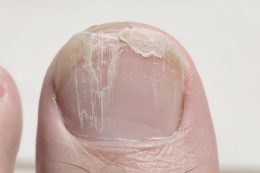Filed under Nail Disorders …
Broken Toenail Treatment Options Explained
Enjoy Healthy Recovery from Broken Toenails
A broken toenail can feel painful and make walking difficult. If this happens to you, you should seek treatment as soon as possible to support healthy healing.
Today, we are going to provide a comprehensive overview of treatments for broken toenails. If you are experiencing this condition, please make an appointment with a podiatrist as soon as possible.
How Do You Know if Your Toenail is Actually Broken?
At a glance, your toenail might seem broken when it is actually still intact. Sometimes the nail is damaged but not completely detached or in need of removal.
Signs of toenail trauma that likely require medical treatment can include:
- Bleeding
- Swelling, redness, and/or throbbing over multiple days
- Intense and/or persistent pain
- Splitting, tearing, or cracking in the nail
- Separation between the nail and nailbed
- A dark reddish or purplish spot underneath the nail
- Abnormal coloration
- Thickened nail, partial or whole
If the toenail has become infected, a person may also notice the presence of pus or experience a fever. If you notice these additional symptoms, seek medical treatment immediately. The infection might require antibiotics or other intervention.
If the Toenail Requires Removal
Should it be necessary, a podiatrist can remove the nail while preventing further damage to the toe. If part of the nail can be preserved, the podiatrist can trim the parts that are broken while leaving the healthy portion intact. Attempting an at-home nail removal is not recommended, as it could result in further injury and increase the risk of infection.
Treatment Options for Borken Toenails
Trimming
As mentioned above, a podiatrist can sometimes trim around the injury to the nail rather than remove it. A partial toenail will grow back in less time than one that was stripped from the nailbed completely.
Complete Nail Removal
Severe injuries might require complete nail removal so that a new one can grow in its place. Podiatrists can determine this during an examination and use specialized equipment to extract the nail without causing further damage to the foot.
Artificial Nails
Artificial nails mimic the function of your natural toenail. A podiatrist may decide to apply one to your nailbed to keep it covered while the toenail regrows.
In some cases, artificial nails can become detached from the toe before the appropriate time. If this happens, contact your doctor and let them know that this happened, and make an appointment to receive a new one.
Keeping the Area Clean
Once the nail has been trimmed or removed, your podiatrist will recommend an aftercare plan. This will usually involve keeping the wounded area clean. In most cases, the easiest way to do this is by soaking the toe in a cleaning solution for a recommended period of time.
Changing Bandages Regularly
Frequently changing the bandages on your toe is essential for healthy recovery. Some times of day where you might want to do this can include:
- Before starting your day in the morning
- After soaking your toe
- After bathing or showering
- After getting home from work or a long outing
- Before going to bed
Before covering your toe with a new bandage, inspect the toe for any signs of infection like redness, pus, or swelling. Be sure to also apply an antibiotic ointment or petroleum jelly to the wounded area beforehand.
Wearing Comfortable Shoes
While your nail is healing, do not wear tight shoes or ones that place pressure on the affected toe. Instead, wear comfortable, closed-toed shoes when leaving home to protect your feet during the recovery process. At home, you can continue to cover your feet or leave them bare.
Taking Antibiotics for Infections
If your toe becomes infected, a doctor might prescribe a course of antibiotics to treat it. Be sure to remain consistent with taking them to prevent the infection from worsening. You can obtain a prescription either through your podiatrist, general practitioner, or walk-in clinic.
Get Treatment for Broken Toenails in Maryland
The Thomas Podiatry & Associates team is proud to be the Delmarva Peninsula’s leading foot care specialists. With multiple locations throughout Eastern Maryland, we can help you treat your broken toenail and create an action plan to support healthy recovery. To see one of our podiatrists, request an appointment online today.






